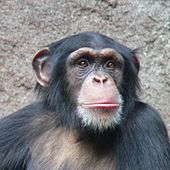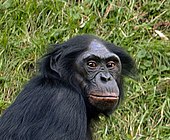The third chimpanzee
The third chimpanzee: Evolution and future of humans is a non-fiction book by Jared Diamond , which was initially published in English in 1991 (original title: The Rise and Fall of the Third Chimpanzee: How Our Animal Heritage Affects the Way We Live ). In his first popular science book presents Diamond primarily from evolutionary perspective, the peculiarities of the people compared to its closest relatives out - the great apes , and especially the chimpanzee . The title of the book is intended to make it clear that humans would have to be classified as a third species next to the common chimpanzee and the bonobo in the genus of chimpanzees if the short genetic distance were considered to be the decisive criterion.
According to Diamond, the crucial characteristics of humans compared to chimpanzees include the life cycle , sexual behavior , language , art , agriculture , drug use , genocide and environmental destruction . Diamond draws on findings from evolutionary biology , linguistics , history , archeology and other disciplines to answer the question of how these peculiarities can be explained. He analyzes why humans developed into the dominant species and what dangers exist today for the continued existence of humanity.
Diamond has detailed topics from the book in three other books, including rich and poor , for which he received the 1998 Pulitzer Prize .
content
The book is divided into five parts, in which different aspects of the biology and behavior of humans are treated. In the first three parts the reasons for the development of humans to the dominant species of the earth are discussed. In the third part and the last two parts, the characteristics of humans are worked out with which they endanger their status as the dominant species on earth.
In the first part of the book entitled "Just a mammal like any other" discussed Diamond, what is so special about the people towards the close relatives, so what the cause of the "Great Leap Forward" (English. Great Leap Forward have been) could. He regards the ability of humans to differentiate vocalizations and the language based on a grammar as essential factors for this and explains this on the basis of the research results of Derek Bickertons , who refines the ideas of a universal grammar developed by Noam Chomsky .
In the second part the life cycle of humans is considered and its special features compared to species closely related to our species are highlighted. One focus here is human sexuality and its developmental significance. For example, in women, in contrast to female chimpanzees, the phase of conception is invisible and the sexual act in humans does not normally take place in front of everyone's eyes. Diamond concludes that "hidden ovulation " and "hidden coitus " strengthen the couple bond and enable a certain constancy in social coexistence. Diamond considers these aspects important for social life to be just as important for the development of language and culture as the anatomical changes.
After the first two parts have dealt with the biological fundamentals, the third part deals with the cultural characteristics that distinguish humans from animals. First of all, human language and art are treated. On the basis of a comparison with the bowerbirds , he shows that “artistic activity” can be important for sexual selection. Diamond then explains that the development of agriculture was not in every way an advance for mankind. He justifies this, for example, with findings from paleopathology , which show more illnesses and deficiency symptoms in people working in agriculture than in hunters and gatherers living at the same time . He also addresses drug consumption by introducing the handicap principle as an explanatory model. Diamond explains this, for example, using the sexually attractive smoking cowboy often portrayed in tobacco advertising .
The fourth part examines how man has spread across the globe. Diamond provides evidence that human expansion has always - also in the past - occurred at the expense of nature and has been accompanied by the extinction of other animal species. In addition, the spread of the particularly successful cultures displaced the less successful ones and was thus directed against their own species. In this context, he also devotes himself in detail to genocide . It also examines the reasons why some cultures have developed faster than others.
The fifth and last part is about whether and in what way mankind is willing to learn from the past, i.e. from the mistakes of earlier societies. Diamond points out that when we analyze the past, we often feel a certain nostalgia . According to Diamond, it is inappropriate to refer to pre-industrial societies - such as the Maori in New Zealand - as " primitive peoples ".
reception
Many of the reviewers think Diamond is particularly well suited to tackling a book on the subject because of his interdisciplinary knowledge. Some of his theses are perceived as daring and provocative.
In March 1992, the New York Times published a review by the zoologist and behavioral scientist Frans de Waal , who deals specifically with chimpanzees . De Waal likes the writing style of the book and he emphasizes the treatises on the development of linguistic diversity, in which Diamond's enthusiasm for the subject is palpable. He also praises the parts of the book that are based on Diamond's personal experiences - for example, his experiences on research trips to Papua New Guinea . De Waal finds Diamond's book particularly appealing because it tries to mediate between the opposing positions of the zoologists, who emphasize the indisputable primate past of humans, and the social scientists, who still place humans somewhere between heaven and earth. What de Waal likes less is that when discussing primate behavior, recent research results are not mentioned, in particular parallels between bonobo and human sexual behavior . De Waal considers much of the book to be daring speculations, but makes it clear that a comprehensive reconstruction of the history of human development is not possible without such speculation.
In his review of March 1995 - after the German edition was published - Josef Reichholf considers the form of the book to be unique. He points out that many of Diamond's answers to behavioral questions cannot be found in medical textbooks. Reichholf suspects, however, that the book could be accused of being too biological. He sees a possible justification for this potential accusation in the fact that the basics presented in the introductory part could not be sufficient as evidence that all the peculiarities of humans presented in the book necessarily result from their evolutionary biological exposure.
Edward O. Wilson predicted on the blurb of the book that The Third Chimpanzee stock will have ( " the third chimpanzee will endure "). This ambiguous prognosis finds at least some confirmation, since the book was reissued in 2005 - after the publication of Kollaps .
Awards
The Third Chimpanzee received the 1992 Royal Society Prize for Science Books of the Royal Society and in the same year the Los Angeles Times Book Prize .
expenditure
| year | publishing company | ISBN |
|---|---|---|
| 1994 | S. Fischer | ISBN 3-10-013902-X |
| 1998 | Fischer Taschenbuch Verlag | ISBN 3-596-14092-7 |
| 2005 | Fischer Taschenbuch Verlag | ISBN 3-596-17215-2 |
The English first edition was published in 1991 under the title The Rise and Fall of the Third Chimpanzee: How Our Animal Heritage Affects the Way We Live at Hutchinson Radius in London. When Harper Collins 1992 under the title The Evolution and Future of the Human Animal: The Third Chimpanzee another edition launched specifically for the US market. After further paperback editions , an additional edition with an updated epilogue was published in 2006 ( ISBN 0-06-084550-3 ).
The book has been translated into more than ten languages. The third chimpanzee was first published in German in 1994 by S. Fischer Verlag . In 1998 an unabridged paperback edition was published by the paperback publishing house belonging to this publisher. The edition, expanded to include the updated epilogue, was published in 2005 by the same publisher. All German editions were translated into English by Volker. In 2009, all German-language editions put together, the book was published for the 15th time. According to the publisher, it is a stable long seller .
Elaboration in further books
Individual subjects dealt with in the “ Third Chimpanzee ” were elaborated in more detail by Diamond in three later, also very well-known books:
- Why is sex fun? (1997) investigates human sexual behavior, which is highly unusual in nature.
- In his pioneering study Arm und Reich (1997), Diamond attributes the current dominance of Eurasian cultures to drastic differences in the natural features of the continents as the main reason.
- In Kollaps (2005) ecological damage is examined, which is caused by societies of earlier times and by humans today.
Individual evidence
- ↑ www.pulitzer.org: The 1998 Pulitzer Prize Winners, General Nonfiction
- ↑ Diamond takes up a Chinese propaganda formula with ironic distance, see Big Leap Forward
- ↑ Review by Silja Inhülsen: Between Vernunft und Triebspektrum.de , January 30, 2007
- ^ Frans de Waal : Separating the Men From the Apes . In: New York Times , March 15, 1992
- ↑ Josef Reichholf : The deadly sins of the third chimpanzee: Jared Diamonds gloomy evolutionary outlook into the future of humans . In: Frankfurter Allgemeine , March 1, 2005
- ^ The Royal Society: Prizes for Science Books previous winners and shortlists
- ^ Los Angeles Times: Los Angeles Times Book Prize Winners, Science and Technology
- ^ Library Thing : The Third Chimpanzee: The Evolution and Future of the Human Animal, Details
- ^ Catalog of the German National Library : The third chimpanzee
- ↑ Information from S. Fischer Verlag of January 23, 2009



